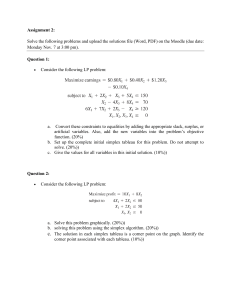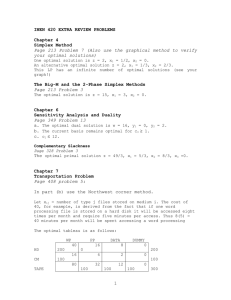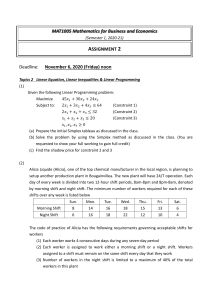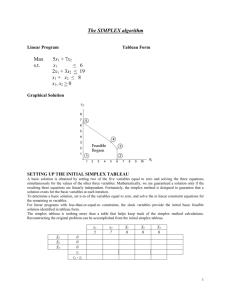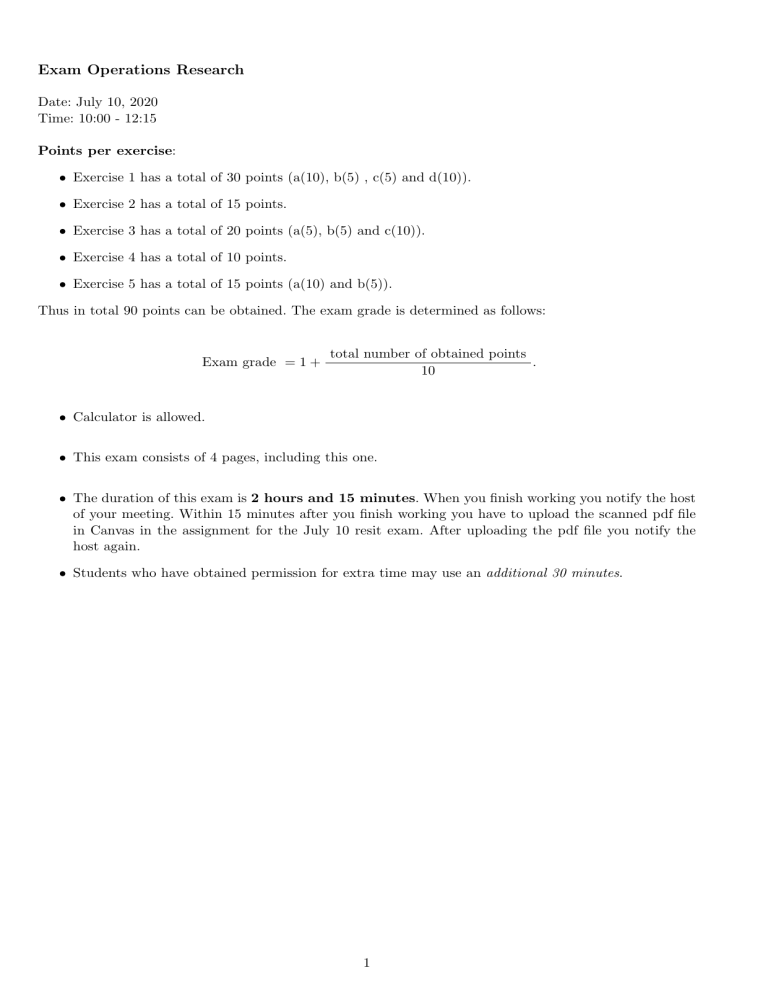
Exam Operations Research Date: July 10, 2020 Time: 10:00 - 12:15 Points per exercise: • Exercise 1 has a total of 30 points (a(10), b(5) , c(5) and d(10)). • Exercise 2 has a total of 15 points. • Exercise 3 has a total of 20 points (a(5), b(5) and c(10)). • Exercise 4 has a total of 10 points. • Exercise 5 has a total of 15 points (a(10) and b(5)). Thus in total 90 points can be obtained. The exam grade is determined as follows: Exam grade = 1 + total number of obtained points . 10 • Calculator is allowed. • This exam consists of 4 pages, including this one. • The duration of this exam is 2 hours and 15 minutes. When you finish working you notify the host of your meeting. Within 15 minutes after you finish working you have to upload the scanned pdf file in Canvas in the assignment for the July 10 resit exam. After uploading the pdf file you notify the host again. • Students who have obtained permission for extra time may use an additional 30 minutes. 1 Exercise 1 Consider the following LP which is referred to as the “primal LP”. min w = 4x1 − x2 + 3x3 + 2x4 s.t. x1 − x2 + x3 + 3x4 ≥ 20 2x1 + x2 + x3 + x4 = 16 x1 , x2 , x3 , x4 ≥ 0 (a) [10 points] Determine the dual of this LP. (b) [5 points] The primal LP has been solved by the simplex method resulting in the following final simplex tableau where s1 is the surplus variable from the first constraint, r1 is the artificial variable from the first constraint and r2 is the artificial variable from the second constraint: x1 x2 x3 x4 s1 r1 r2 value Basic w w 1 −3.75 0 −2.50 0 −0.75 0.75 −0.25 11.00 x4 0 0.75 0 0.50 1.00 −0.25 0.25 0.25 9.00 x2 0 1.25 1.00 0.50 0 0.25 −0.25 0.75 7.00 Determine the optimal solution of the primal LP and optimal objective value. Determine also the optimal solution of the dual LP and optimal dual objective function. (c) [5 points] The right hand side of the second constraint is changed to 12 instead of 16. Determine the optimal solution of this modified primal LP and the corresponding optimal objective value. Instruction: This optimal solution can be found by sensitivity analysis using the above simplex tableau without doing any pivot step. (d) [10 points] Now the right hand side of the second contraint is not changed (thus it is 16 as in the original LP problem), but the coefficent in the objective function before x4 is changed to -2 instead of 2. Adjust the simplex tableau accordingly and apply the simplex method to determine the optimal solution and optimal objective value of this modified LP. It will require one pivot step to find the new optimal solution. Also explain why it follows from the simplex tableau which you obtain after one pivot step that the corresponding solution is the optimal solution of the modified LP. Instruction: Since the primal solution you have determined in exercise 1b is still feasible (but it will be no longer optimal) you can leave out the columns of the two artificial variables in your calculations to spare some time. Moreover, if you do the calculations correctly then in the final simplex tableau all values will be integers. Exercise 2 There are 7 files (i = 1, 2, . . . , 7) which have to be stored on USB sticks. For storing these files there are two USB sticks available with storage capacities of respectively 32 MB and 16 MB. The sizes of the 7 files are respectively 6 MB, 5 MB, 3 MB, 9 MB, 4 MB, 6 MB and 11 MB. Each file should be stored at one of the USB sticks. Moreover, because of a security issue the files numbered 2 and 7 may not be stored on the same USB stick. (a) [15 points] Formulate an integer linear program for this problem. Formulate the objective function such that if there exist feasible solution(s) that then the total amount of MB’s which are stored on the stick with 32 MB capacity is minimized. Explain the meaning of all variables and constraints you have in your formulation. Pay attention that the formulation (besides that you may use integer or binary variables) has to be linear. 2 Exercise 3 Consider the following problem. You are packing your suitcase for a journey and need to decide what items to bring. You have 4 items (just one of each); each has a certain value to you, and a certain weight: weight (kg) value 4 10 7 17 3 8 5 14 You do not want to have more than 10 kg of weight in the suitcase. The problem is to choose under that weight restriction which items should be put into the suitcase maximizing the total value of those items. (a) [5 points] Formulate an integer linear program for this problem. (b) [5 points] Determine the unique optimal solution of the LP relaxation of this problem. Also determine the corresponding optimal objective value. (c) [10 points] Solve the ILP from (a) by applying the branch-and-bound method. Clearly indicate in which order you compute the nodes of the search tree and where you prune the search tree. Also indicate which pruning criterion you use when you prune. Exercise 4 (a) [10 points] Consider the problem of finding a minimum weight spanning tree in the non-directed graph below (where edge weights have been indicated) using Prim’s algorithm choosing node A as initial tree. Make clear in which order the edges are picked by the algorithm and draw the minimum weight spanning tree which is finally obtained. Explain your answer briefly. 3 Exercise 5 Consider the directed graph shown below with length of the arcs as indicated. (a) [10 points]. Apply Dijkstra’s algorithm to determine a shortest path from node A to node J in this directed graph. It should be clear from your work that you have applied Dijkstra’s algorithm to determine a shortest path. At the end clearly draw the shortest path which you have found. (b) [5 points]. The arcs (E, D) and (E, F ) are removed from the directed graph and can no longer be used on any path between two nodes. In this modified directed graph determine a shortest path from node A to node J by applying backward recursion. It should be clear from your work that you have applied backward recursion to determine a shortest path. At the end clearly draw the shortest path which you have found. 4
